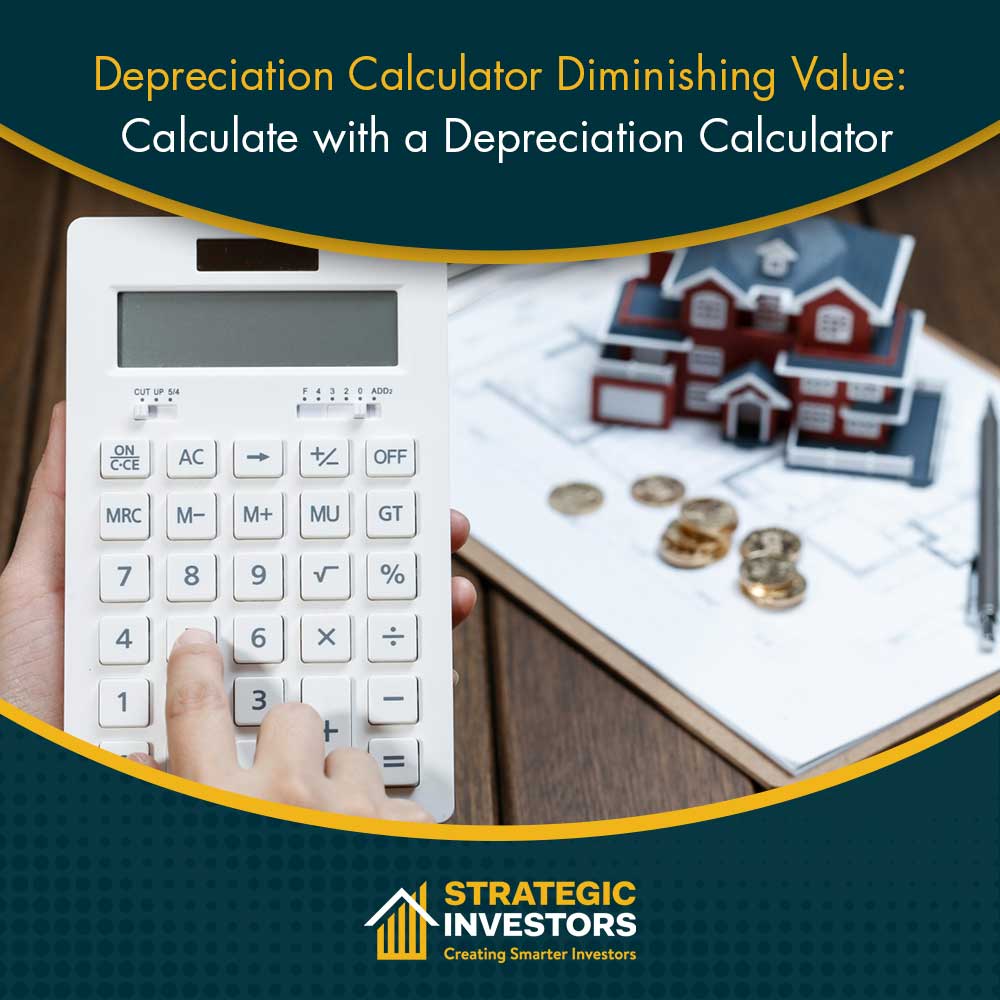
Are you struggling to navigate the world of property depreciation? You’re not alone. Many property investors find it challenging to understand the intricacies of depreciation and how it can impact their tax deductions.
This comprehensive guide will demystify the complex world of depreciation calculators, specifically the depreciation calculator diminishing value, and show you how to make informed decisions when choosing the right one for your property investment needs.
Let’s dive in and explore the various aspects of property depreciation, the importance of selecting the right calculator, and tips for maximizing your deductions using the diminishing value method.
Key Takeaways
- Property depreciation is the reduction in an asset’s value over time, and a depreciation calculator can help to accurately calculate it.
- Different types of calculators are available with varying features, accuracy levels, customizability and compliance with government regulations.
- It is important to consider property details and compare different calculators in order to make informed decisions about investments.
What is Property Depreciation
 Property depreciation refers to the decrease in an asset’s value over time, with the diminishing value and prime cost methods being the most commonly employed approaches to calculating it for tax purposes. An investment property depreciation calculator can help estimate deductions based on property information and a chosen depreciation method. These deductions can have a significant impact on the cash flow and tax return of property investors. Obtaining a property depreciation report can further assist in understanding and maximizing these deductions.
Property depreciation refers to the decrease in an asset’s value over time, with the diminishing value and prime cost methods being the most commonly employed approaches to calculating it for tax purposes. An investment property depreciation calculator can help estimate deductions based on property information and a chosen depreciation method. These deductions can have a significant impact on the cash flow and tax return of property investors. Obtaining a property depreciation report can further assist in understanding and maximizing these deductions.
Maximizing tax deductions and ensuring compliance with government regulations is contingent on understanding property depreciation and accurate calculation of it, regardless if you’re a seasoned investor or a beginner.
Understanding Diminishing Value Depreciation
The diminishing value method, also known as the declining balance depreciation method, allows for greater deductions in the initial years of an asset’s life, with reduced deductions in subsequent years. This method can be particularly beneficial for assets with shorter effective lives, such as plant and equipment. The depreciation rate is calculated by dividing the number 200 by the item’s effective life and expressing it as a percentage.
In contrast, the prime cost method provides a fixed rate of depreciation, which remains constant throughout the asset’s life. Your tax deductions can be significantly impacted by the depreciation method you choose. Thus, considering the pros and cons of each method is a step you should not overlook.
What is the Prime Cost Method?
The prime cost method calculates depreciation at a fixed rate each year based on the asset’s effective life. This method claims a fixed amount annually, determined by the asset’s effective life as set by the Australian Taxation Office (ATO). An asset which has an effective life of five years can be claimed for depreciation. For example, if it costs 80,000$, then the depreciation amount per year could be 20%, i.e., 16,000$. This is applicable for all five years..
In comparison, the diminishing value method allows for higher deductions in the early years of an asset’s life, which may be more suitable for assets with shorter effective lives.
Government Regulations on property investment depreciation
Government regulations play a vital role in determining depreciation rates and methods for property investments. For example, Low-Value Pooling is a method of calculating depreciation value for assets that cost less than $1,000, with the annual depreciation value determined by multiplying the total cost of the assets in the pool by 18.75%.
The Division 43 Building Write-Off Allowance offers a tax deduction for capital improvements. Property investors need to stay informed about the latest government regulations and guidelines on depreciation, guaranteeing accurate calculations and compliance.
How It Works
A depreciation calculator is a valuable tool that can help you estimate deductions based on property information and a chosen depreciation method. These calculators come in various formats, such as:
- Online tools
- Mobile apps
- Software
- Excel spreadsheets
Factors such as accuracy, ease of use, customizability, and adherence to government regulations should be top of mind when selecting a depreciation calculator.
A depreciation calculator aids in making informed decisions about your property investments and guarantees that you’re claiming the maximum depreciation deductions.
Advantages and Disadvantages of using a calculator
While using a depreciation calculator has numerous advantages, such as precise calculations, time-saving, and financial planning, there are also some drawbacks to consider. One common drawback is that these calculators may not take into account all relevant factors and variables that could influence the depreciation of a property, potentially leading to inaccurate calculations and incorrect financial decisions.
While online property depreciation calculators offer reasonable estimates, bear in mind they may not account for all elements influencing depreciation, like specific local regulations or unique property traits. For more precise estimations, seeking advice from a professional tax advisor or quantity surveyor is advised.
Using a Specialised Property Depreciation Specialist
Employing a specialized property depreciation specialist can yield more precise and customized depreciation schedules. These specialists possess expert knowledge and experience in the field of property depreciation and can provide a single schedule for 40 years of eligible deductions.
Engaging a specialist property depreciation consultant guarantees accurate calculations, maximized tax deductions, and enhanced cash flow.
Should you use a professional Quantity Surveyor to with Depreciation Schedules
Hiring a professional Quantity Surveyor can ensure accurate and compliant depreciation schedules for tax purposes. These professionals possess the necessary qualifications and expertise to accurately estimate the depreciation of capital allowance and capital works for both individuals and businesses.
Furthermore, they can keep property owners updated on the latest regulations, ensuring precise depreciation calculations and compliance with governmental rules.
Types of Depreciation Calculators
 Depreciation calculators come in various forms, each with its own unique features and benefits. Some options include:
Depreciation calculators come in various forms, each with its own unique features and benefits. Some options include:
- Online tools
- Mobile apps
- Software
- Excel spreadsheets
There is a wide range of calculators available to suit different needs and preferences.
In the forthcoming sections, we’ll delve into various types of depreciation calculators, shedding light on their unique benefits to assist in your decision-making process when selecting the right one for your property investment needs.
Online Depreciation Calculators
Online depreciation calculators are easily accessible and often free to use, making them a popular choice for property investors. These calculators typically provide reasonably accurate estimations of depreciation deductions for investment properties based on the property’s characteristics. However, it’s essential to remember that online calculators may not take into account all factors that can influence depreciation, such as particular local regulations or unique property features.
To obtain a more precise estimation, consider consulting with a professional tax advisor or quantity surveyor.
Mobile Apps and Software
Mobile apps and software offer more features and customization options compared to online calculators. These tools can provide more accurate and tailored depreciation schedules, as well as additional functionality such as asset management and reporting capabilities.
However, mobile apps and software may have a steeper learning curve and may require a financial investment to access all features and benefits.
Excel Spreadsheets

Depreciation Schedules
Depreciation schedules provide a detailed breakdown of depreciation deductions over time, helping property investors make informed decisions about their investments. These schedules outline the deductions available on an investment property, including both the building structure (capital works) and the assets within the property (plant and equipment).
Utilizing a depreciation schedule allows property owners to make accurate depreciation deduction claims and optimize their tax returns.
Step-by-Step Guide: Using a Depreciation Calculator

Inputting Property Information
Providing accurate property information when using a depreciation calculator is fundamental to ensure precise depreciation estimates. Typically, you’ll need to input details such as:
- The purchase price of the property
- The date of purchase
- The type of property (residential or commercial)
- The construction date
- Any renovations or improvements made
Keep in mind that the specific input fields may differ depending on the depreciation calculator being used.
Selecting the Diminishing Value Method
Once you’ve inputted the property information, you’ll need to select the depreciation method that best suits your needs. If you’re looking for higher deductions in the early years of an asset’s life, the diminishing value method may be the best choice.
This method calculates depreciation at a higher rate in the early years of an asset’s life, resulting in larger deductions during this period.
Analyzing Results
After selecting the depreciation method and inputting the property information, the tax depreciation calculator will provide an estimate of the depreciation deductions you may be eligible for, based on the estimated depreciation of your property.
Analyzing the results is vital to make informed decisions about your property investments. Consider factors such as:
- The asset cost
- Salvage value
- Useful life
- Obsolescence
when analyzing the results.
Understanding your property’s potential tax depreciation deductions grants you the ability to make well-informed decisions about your property investments.
Factors to Consider When Choosing a Depreciation Calculator
 When selecting a depreciation calculator, there are several factors to consider to ensure you choose the best tool for your needs. In this section, we’ll explore how factors like:
When selecting a depreciation calculator, there are several factors to consider to ensure you choose the best tool for your needs. In this section, we’ll explore how factors like:
- Accuracy
- Ease of use
- Customizability
- Compliance with government regulations
play a role when selecting a depreciation calculator.
Accuracy
Accuracy is vital when using a depreciation calculator, as inaccurate calculations can lead to incorrect financial decisions and potential non-compliance with tax regulations. To ensure the calculator provides accurate estimates based on up-to-date regulations, look for calculators that are regularly updated and adhere to the latest government guidelines
Ease of Use
A user-friendly depreciation calculator can simplify the process to calculate depreciation and make it more accessible to users of all levels of proficiency. Look for calculators with an easy-to-use design and navigation, clear instructions, and quick and accurate results.
Customizability
Customizability is essential in a depreciation calculator, as it allows you to adapt the calculations to your specific property and financial situation. Different properties have different characteristics and depreciation rates, so being able to customize the calculator ensures accurate and individualized outcomes.
Look for calculators that offer customization options, such as the ability to input specific property details or choose different depreciation methods.
Government Regulations
Compliance with government regulations is crucial when using a depreciation calculator, as non-compliance can result in penalties and potential legal issues. Ensure the calculator you choose adheres to the latest government guidelines and regulations for depreciation calculations, and consider consulting with a tax professional or quantity surveyor for additional guidance.
Tips for Maximizing Depreciation Deductions with Diminishing Value Method
 Now that we’ve explored the various aspects of depreciation calculators, let’s discuss some tips for maximizing depreciation deductions using the diminishing value method. With these strategies, further optimization of your tax deductions and enhancement of property investment returns is possible.
Now that we’ve explored the various aspects of depreciation calculators, let’s discuss some tips for maximizing depreciation deductions using the diminishing value method. With these strategies, further optimization of your tax deductions and enhancement of property investment returns is possible.Asset Selection
Choosing assets with shorter effective lives can result in higher depreciation deductions, as these assets tend to depreciate at a faster rate than those with longer lives. Examples of assets with shorter lifespans include:
- Technology equipment
- Vehicles
- Machinery and equipment
- Furniture and fixtures
By strategically selecting assets with shorter lifespans, you can maximize your depreciation deductions and enhance your property investment returns.
Timing of Asset Purchases
Timing your asset purchases strategically can help maximize deductions in the early years of ownership. By acquiring assets at the beginning of the financial year or just before the end of the tax year, you can maximize the depreciation deductions for that year. Additionally, consider taking advantage of accelerated depreciation and bonus depreciation allowances offered by the government to further increase your deductions.
Regular Property Inspections
Conducting regular property inspections can help you identify and claim depreciation on new assets. These inspections can aid in accurately evaluating the property and its assets in terms of condition and value, ensuring that all entitled depreciation deductions are claimed.
Additionally, inspections can identify any new assets that have been added to the property, which can then be added to the depreciation schedule.
Use a professional property investment depreciation company
Hiring a professional property investment depreciation company can provide more accurate and tailored depreciation schedules, ensuring you claim the maximum depreciation deductions available to you. These companies possess expert knowledge and experience in the field of property depreciation, and can help you navigate the complex world of depreciation calculations and tax compliance.
Engaging a professional property depreciation specialist facilitates maximized tax deductions, enhanced cash flow, and better-informed decisions about your property investments.
Case Study: Comparing Depreciation Calculators
 In this case study, we will compare various depreciation calculators to highlight the importance of property details, calculator comparison, and lessons learned from the comparison.
In this case study, we will compare various depreciation calculators to highlight the importance of property details, calculator comparison, and lessons learned from the comparison.
This comparison aims to offer valuable insights, aiding in informed decision-making about your property investments and depreciation calculations.
Property Details
When comparing depreciation calculators, it’s crucial to provide accurate property details for more precise depreciation estimates. Factors such as:
- Age
- Condition
- Location
- Features
of a property can influence its value, and by inputting accurate property information, the depreciation calculator can provide a more precise estimation of the property’s depreciation over time.
Calculator Comparison
Comparing different depreciation calculators can help you find the best fit for your individual property investment needs. By examining the features, accuracy, ease of use, customizability, and compliance of different calculators, you can make an informed decision when choosing the right calculator for your property investments.
Lessons Learned
By comparing different depreciation calculators, you can learn valuable lessons about:
- The importance of accuracy
- Ease of use
- Customizability
- Compliance with government regulations
These lessons can inform your future property investment decisions and help you optimize your depreciation deductions, ultimately enhancing your property investment returns.
Summary
In conclusion, understanding property depreciation and choosing the right depreciation calculator are critical aspects of property investment. By considering factors such as accuracy, ease of use, customizability, and compliance with government regulations, you can make informed decisions about your property investments and maximize your depreciation deductions. Use this comprehensive guide as a roadmap to navigate the complex world of depreciation calculators and make better-informed decisions about your property investments. Remember, knowledge is power, and with the right tools and strategies, you can optimize your property investment returns and achieve financial success.
Frequently Asked Questions














